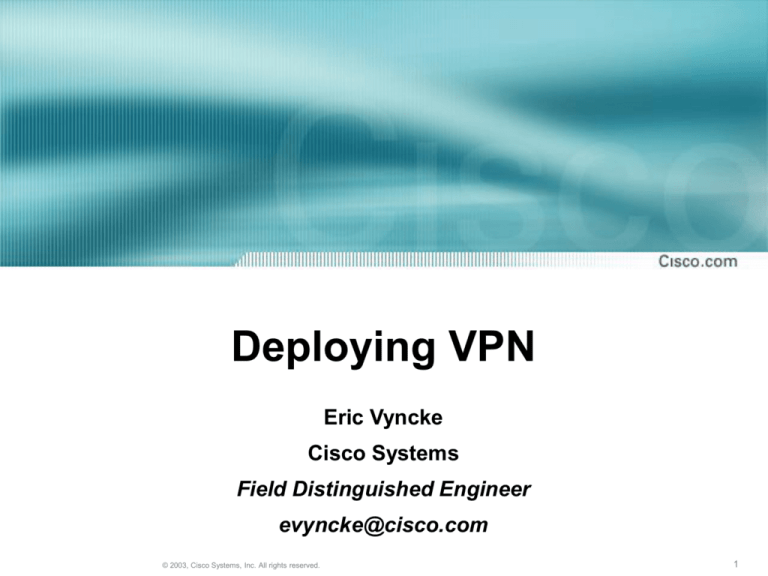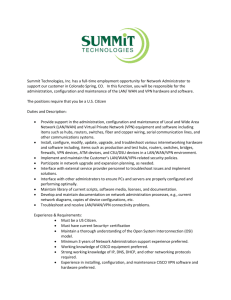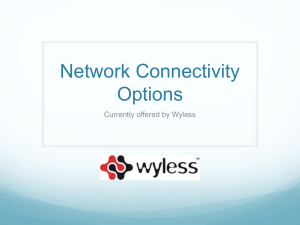
Deploying VPN
Eric Vyncke
Cisco Systems
Field Distinguished Engineer
evyncke@cisco.com
© 2003, Cisco Systems, Inc. All rights reserved.
1
Forewords
Focus mainly on VPN for one organization
Evyncke ucl vpn workshop
© 2003, Cisco Systems, Inc. All rights reserved.
2
Agenda
• Cisco Definition of VPN
• Using Layer 3 Tunnels & Routing
• Security of the Above
• Existing Techniques for Dynamic VPN
• Deployment Examples
Evyncke ucl vpn workshop
© 2003, Cisco Systems, Inc. All rights reserved.
3
Virtual Private Network (VPN) Defined
“
A Virtual Private
Network Carries Private
Traffic Over
a Public Network
Cisco 'official' definition
Evyncke ucl vpn workshop
© 2003, Cisco Systems, Inc. All rights reserved.
”
4
What Is a “Public” Network?
• In this context, any network shared among
different administrative domains
• A shared network such as the Internet
• A privately owned network which services
many external/internal customers
Evyncke ucl vpn workshop
© 2003, Cisco Systems, Inc. All rights reserved.
5
What is 'Private' Traffic?
• Can be anything desired by an
organization
Confidentiality => IPSec
IP Routing independance (address and IGP) =>
MPLS & RFC 2547
QoS end to end
Efficient multicast
Evyncke ucl vpn workshop
© 2003, Cisco Systems, Inc. All rights reserved.
6
The Three Categories of VPN
Intranet VPN
Low cost, tunneled
connections with
rich VPN services,
like IPSec
encryption and
QoS to ensure
reliable throughput
Home
Office
Main
Office
POP
Remote
Office
WAN VPN
POP
Remote Access VPN
Secure, scalable,
encrypted tunnels
across a public
network, client
software
Extranet VPN
Extends WANs to
business
partners
Evyncke ucl vpn workshop
Business
Partner
© 2003, Cisco Systems, Inc. All rights reserved.
Mobile
Worker
7
Technologies
• A large choice
BGP/MPLS VPN
IPSec
My main focus
Layer 3: IPinIP, GRE, IPv6 over IPv4
Layer 2: L2TP
IEEE 802.1q VLAN
Evyncke ucl vpn workshop
© 2003, Cisco Systems, Inc. All rights reserved.
8
Another Cisco Taxonomy
VPN
Network Based VPN
L2VPN
L3VPN
MPLS VPN
Evyncke ucl vpn workshop
CPE Based
© 2003, Cisco Systems, Inc. All rights reserved.
IPSec/GRE
Network Based IPSec
9
Agenda
• Cisco Definition of VPN
• Using Layer 3 Tunnels & Routing
• Security of the Above
• Existing Techniques for Dynamic VPN
• Deployment Examples
Evyncke ucl vpn workshop
© 2003, Cisco Systems, Inc. All rights reserved.
10
Examples
• The most common layer 3 tunnels are
IP in IP: RFC 2003
GRE: RFC 2784
Default on Cisco
routers
• The most common layer 2 tunnels are
PPTP, L2F: deprecated
L2TP: RFC 2661
L2TPv3: aka UTI
Evyncke ucl vpn workshop
© 2003, Cisco Systems, Inc. All rights reserved.
11
IPSec Tunnel Mode Encapsulation
Original IP datagram
Original IP header
Protocol=p
IP payload
20 bytes
IPSec ESP without ESP auth encapsulation (after encapsulation)
ESP header
Original IP header
Protocol=4 (IPinIP)
Protocol=p
16 bytes
IP payload
20 bytes
ESP
trailer
2-10 bytes
IPSec packet with new IP header (on the wire)
External IP header ESP header Original IP header
Protocol=50 (ESP)
20 bytes
Evyncke ucl vpn workshop
Protocol=4
16 bytes
© 2003, Cisco Systems, Inc. All rights reserved.
Protocol=p
IP payload
20 bytes
Encrypted payload
ESP
trailer
2-10 bytes
12
IPinIP + IPSec Transport Mode
Original IP datagram
Original IP header
Protocol=p
IP payload
20 bytes
IPinIP Encapsulation
External IP header Original IP header
Protocol=4 (IPinIP)
Protocol=p
IP payload
20 bytes
20 bytes
After IPSec Transport Mode
External IP header ESP header Original IP header
Protocol=50 (ESP)
20 bytes
Evyncke ucl vpn workshop
Protocol=4
16 bytes
© 2003, Cisco Systems, Inc. All rights reserved.
Protocol=p
IP payload
20 bytes
Encrypted payload
ESP
trailer
2-10 bytes
13
Differences with IPSec Tunnel Mode
• Same syntax (bits on the wire):
IPSec Tunnel Mode
IPinIP + IPSec Transport Mode
• Is it the same semantic ? No
• Because SPD is now replaced by routing
Ease of deployment
Resiliency
Less security
Evyncke ucl vpn workshop
© 2003, Cisco Systems, Inc. All rights reserved.
14
Difference: SPD & SAD
Trivial selectors
Easy provisioning
One pair of SA
Very scalable
• IPinIP + IPSec Transport Mode
<L3 endpoint, L3 endpoint, IPinIP, *,*>
Usually one pair of SA
• IPSec Tunnel Mode
<protected net., protected net.,*,*,*>
Can potentially be multiple pairs of SA
Evyncke ucl vpn workshop
© 2003, Cisco Systems, Inc. All rights reserved.
15
Difference: Cisco Router IOS view
• IPinIP + IPSec: is a L3 tunnel interface
Routing Protocol
Multicast, ..
This means strong
resilience
And fast re-routing
• IPSec Tunnel mode: is not
Evyncke ucl vpn workshop
© 2003, Cisco Systems, Inc. All rights reserved.
16
Difference: SA Selection
• IPinIP + IPSec Transport Mode
L3 tunnel is selected by FIB
FIB is dynamic (insecure)
• IPSec Tunnel Mode
IPSec SA selected by SAD
SAD is static (secure)
Evyncke ucl vpn workshop
© 2003, Cisco Systems, Inc. All rights reserved.
17
Traffic can be Routed Through 2 Hubs
Central Site
Hub 1 (active)
Hub 2 (active)
+ Easier.
+ Hub are always
under 50% load.
- Asymmetric routing
Evyncke ucl vpn workshop
© 2003, Cisco Systems, Inc. All rights reserved.
18
Traffic can be Load Balanced
Central Site
Hub 1 (active)
Need to tune IGP
to always select
the GREEN
tunnels.
Evyncke ucl vpn workshop
© 2003, Cisco Systems, Inc. All rights reserved.
Hub 2 (active)
+ Symmetric routing
+ Both hubs running at
50%
19
Agenda
• Using Layer 3 Tunnels & Routing
• Security of the Above
• Existing Techniques for Dynamic VPN
• Deployment Examples
Evyncke ucl vpn workshop
© 2003, Cisco Systems, Inc. All rights reserved.
20
Agenda
• Using Layer 3 Tunnels & Routing
• Security of the Above
• Existing Techniques for Dynamic VPN
• Deployment Examples
Evyncke ucl vpn workshop
© 2003, Cisco Systems, Inc. All rights reserved.
28
Next Hop Resolution Protocol, RFC 2332
• IETF protocol
• Used on NBMA Non Broadcast Multi-Access networks
(Frame Relay, X.25, …) to discover peers
• Can also be used on multi-point GRE, mGRE
Specific kind of GRE tunnel
Fan-out like: one hub and multiple spokes
Hub can speak direct to all spokes
Spokes can only talk to hub
• Cannot be used over IPinIP since NHRP does not
run over IP
Evyncke ucl vpn workshop
© 2003, Cisco Systems, Inc. All rights reserved.
29
NHRP over mGRE
NHRP Server
NHRP Cache
mGRE
Client Y is via 3.3.3.3
2.2.2.2
NHRP Client X
3.3.3.3
NHRP Client Y
NHRP Cache
Client Y is via 3.3.3.3
Evyncke ucl vpn workshop
© 2003, Cisco Systems, Inc. All rights reserved.
30
Tunnel Endpoint Discovery
Proposed to IETF
IPSP WG
Alice
X1
IP: A to B
A to B
must be protected
no SA => send probe
X2
Y
Traffic to B
must be protected
no SA & probe received
=> block & answer probe
Evyncke ucl vpn workshop
© 2003, Cisco Systems, Inc. All rights reserved.
Bob
31
NRHP, TED and Routing
• NHRP+mGRE requires routing inside the
GRE tunnel to learn about connected
networks
• TED requires routing in the core to learn
about connected networks
Evyncke ucl vpn workshop
© 2003, Cisco Systems, Inc. All rights reserved.
32
Agenda
• Using Layer 3 Tunnels & Routing
• Security of the Above
• Existing Techniques for Dynamic VPN
• Deployment Examples
Evyncke ucl vpn workshop
© 2003, Cisco Systems, Inc. All rights reserved.
33
Case #1: 1500 Nodes Hierarchical
Network With IPX
• Customer: large retail bank
• Requirements:
Mix of IP and IPX traffic
Large scale 1500 nodes
Hierarchical structure: branch, regional office
Bandwidth: 128 kbps, 512 kbps & 10 Mbps
Outsourced IP services
Evyncke ucl vpn workshop
© 2003, Cisco Systems, Inc. All rights reserved.
34
Case #1: Issues
• Large scale
Need to use a layered structure
• Mix of IPX & IP
Use of GRE encapsulation
• High Availability (Resilience)
Use routing protocol (EIGRP for IP & IPX)
• Outsourced IP services
1 router managed by IP Service Provider
1 router managed by customer (IPSec)
Evyncke ucl vpn workshop
© 2003, Cisco Systems, Inc. All rights reserved.
35
Case #1: IPSec Overlay Network
HQ
approx. 2;
200 tunnels per router,
can be split over several
routers
RO
approx. 600;
15 tunnels to branches
4 tunnels to BO
BO
approx. 800;
1 tunnel per branch
Evyncke ucl vpn workshop
© 2003, Cisco Systems, Inc. All rights reserved.
36
Case #2: MPLS BGP VPN & IPSec
• Customer: SP for a bank
• Requirements
Outsourced network: connectivity & security
Double management ?
Interworking with MPLS (RFC 2547)
300 Nodes
Evyncke ucl vpn workshop
© 2003, Cisco Systems, Inc. All rights reserved.
37
Case #2: Network
Green VPN
MPLS Network
Use of Tunnel Endpoint
Discovery
Red VPN
2 Mbps
Evyncke ucl vpn workshop
© 2003, Cisco Systems, Inc. All rights reserved.
38
Case #3: Mapping IPSec Remote
Access to another VPN
• SP customer
• Wants to connect remote user over a
remote access IPSec VPN to
Specific L3 VPN: GRE, BGP/MPLS
Specific L2 VPN: Frame Relay, 802.1Q VLAN
• Solution: IPSec termination in different
VRF based on IKE identity
Evyncke ucl vpn workshop
© 2003, Cisco Systems, Inc. All rights reserved.
39
Case #3: IPSec to BGP/MPLS VPN
Branch Office
IPSec VPN
MPLS/VPN
Customer A
Remote Access
MPLS Network
PE
Internet
Internet
Gateway
IPSec-AGG
PE
PE
Customer B
Telecommuter/SOHO
Mapping offnet users into BGP/MPLS VPNs.
Evyncke ucl vpn workshop
© 2003, Cisco Systems, Inc. All rights reserved.
40





